OSTERVILLE – When David Lewis, 71, was a young man, “I took a job, temporarily, as a plumber’s helper until I figured out what I was going to do with my life.”
Thirty-five years later, when he retired as a plumber, he had figured it out. He became a sculptor.
Lewis, who recently unveiled his latest creation, the Rachel Carson statue in Woods Hole, is Cape Cod’s go-to artist for iconic public space statues of historical figures. Among many, he carved the John F. Kennedy and Iyanough statues in downtown Hyannis, and the Mercy Otis Warren and James Otis Jr. statues at the Barnstable County Courthouse.
That’s what he has done with his life. He has created something close to an immortal legacy. It’s really rather astonishing, considering how it all started.
“In 1975, I was dealing with a drinking problem. I tried to quit on my own but I was going a little nuts,” he said. “For some reason, I borrowed a half dozen chisels and I got a big hunk of mahogany and I started carving.” He didn’t know why, maybe because of the 12-step programs he had been attending, but he carved the head of Christ at Gethsemane.
While he battled his addiction, for a while he thought, “It isn’t booze that’s been my problem. I haven’t had any religion. I thought it was the answer to my screwed up life when the real answer was stop drinking and put your life together. Quitting is a very long process, by the way.”
Through this process, he and his wife Nancy separated a few times, and Lewis came to deal with his coming from “a blue collar family. Working in a blue collar job. I worked hard and played hard. It was drinking with the boys.”
For a couple of years, he continued to drink, continued to work as a plumber, and began a secret life as a sculptor. “More than once, I saw the sun come up,” he said. “I thought I was nuts, especially when I started doing abstract stuff.”
He had this compulsion but would not admit to anyone, not even himself, that he was an artist. After all, the people he hung out with would never hang out with an artist. Calling yourself an artist in his circles, he said, was the mark of a phony.
A Child of Osterville
“We were the poor people in a very wealthy village,” said Lewis of his childhood in Osterville. His father was a plumber and his mother cleaned the houses of the rich people in the village.
Lewis recalled that “when I was in high school, I could draw better than most,” but he never pursued anything artistic. All he wanted to do was have fun. He was a middle linebacker and a center on the high school football team, and dating the head cheerleader. Life was good.
It was so good that when his high school football coach told him that the coach managed to land Lewis a football scholarship to Dean Junior college, “I looked him in the eye and said, ‘Thanks coach, but no thanks.’ “ Decades later, he has no idea why he turned down the scholarship. At the time, it wasn’t what he wanted.
“I marvel at kids today who know what they want to do,” he said. He had no inkling as a high school graduate, so he got a job on the original Atlantis research sailing vessel of the Woods Hole Oceanographic Institution. When he was not out at sea, he “raised holy hell.”
He had it so good, he said, that he could quit in the spring and get rehired in the fall. “Girls, summer. Who the hell wants to go to sea in the summer?” he said.
After three years of going to sea, with the Vietnam war cranking up, he applied to become a pilot but he didn’t pass the eye test. He stayed on the Cape and with his last youthful summer approaching, he became a lifeguard at Craigville Beach and again “raised holy hell.”
Lewis met his wife in a bar and they got married in 1964.
Finding His Artistic Identity
Lewis started carving in 1975. He finally quit drinking in 1977. But it wasn’t until 1984 that he was finally able to admit to himself that he was an artist.
When he first started carving, he was doing smaller pieces in mahogany. A lot of abstract stuff. When he gave a piece to a friend with a gallery, and it sold for $100, Lewis said he was thrilled but “I didn’t throw away my plumbing tools.”
He had a dilemma. His art was getting better and he wanted to dedicate more time to it, but “I’ve got these four kids who will not stop eating,” he recalled.
While continuing his spiritual quest to get his life together, he went to a counselor in Cambridge who was a female high school principal who was on leave from her job in California. He told her he wanted to be an artist but he had to keep working to support his family. “And she convinced me that plumbing was my way of becoming an artist,” he said.
In 1984, shortly after that, he was in his plumbing truck driving to a job when a thought struck him. There was no more denying. No worrying that his friends would think he was “a phony.” Instead, he admitted a truth to himself. “I finally said, ‘I’m an artist.’ “
Carver of Icons
After nine years of creating art and finally admitting that he was an artist, Lewis was presented with an opportunity that would change his life.
A one-time Osterville priest that Lewis had seen for counseling occasionally during his drinking days was assigned to a new church in Mashpee. “He ran into Nancy and asked ‘what is David doing?’ “ She told the priest about Lewis’ art. “He said, ‘I’d like to come see his work.’ “
When the priest came to visit, he asked Lewis if he’d ever done any life-sized sculptures, and he showed the priest a life-sized Indian he had carved with a chainsaw and chisels.
The priest commissioned Lewis to carve a Jesus with John The Baptist statue. He took him 46 months. Then he got a job to do Mary and Joseph statues at the same church. He started the Joseph statue but by this time in his career, “I had breathed so much mahogany dust that I came down with mahogany asthma.”
So after 13 years of woodcarving, he developed a new definition of himself. “It dawned on me that I am not a wood carver but rather a sculptor that worked in wood.”
He changed his medium to clay which is then cast in bronze, and his health improved.
His first clay carving, of Joseph, was cast in rugged plastic to make it look close to the other mahogany statues.
With the church statues as models others found, Lewis was “discovered” and he was commissioned for the Barnstable County Courthouse to do statues of James and Mercy Otis, heroes of the American revolution. From there, more commissions came, including John F. Kennedy, Iyanough, and a even series of native American sculptures.
He is currently working on a statue of a fisherman for the 100th anniversary of the Cape Cod Canal.
Legacy
“For my first piece, I was just trying to stay sober,” said Lewis “I never really had a plan.”
And now he is creating iconic historic statues in public places.
In bronze.
“I know bronze,” he said when asked of his legacy. “Bronze lasts thousands of years. But I don’t dwell on it. I can’t dwell on it. I’m too busy thinking about my next one.”
It’s art. The dwelling is up to us.
— Brian Tarcy


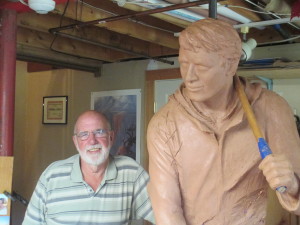
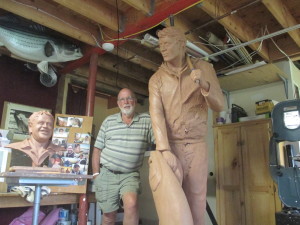

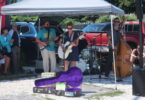
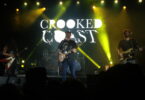










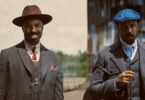





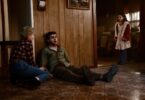




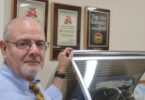
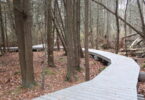


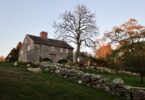
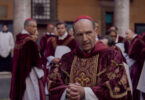
This is a FABULOUS STORY on many levels but particularly, regarding Dave’s recovery of who he was all the time-an artist waiting to express himself in some creative fashion.
This should send a message to parents and educators alike.
We have been ‘created’ by a creator to create.
Its’ time we realized we need to encourage our young people to really find their gift and then, as Joseph Campbell urged, “Follow Your Bliss.”
Congratulations for a very moving and well researched story about Lewis overcoming his demons through art.
Howdy I am so grateful I found your webpage, I really
found you by error, while I was looking on Google for something else,
Regardless I am here now and would just like to say thanks for a incredible
post and a all round enjoyable blog (I also love the theme/design), I don’t have time to read it all at the minute but
I have saved it and also added your RSS feeds, so when I have time I will
be back to read more, Please do keep up the excellent
jo.